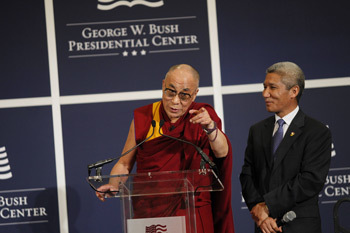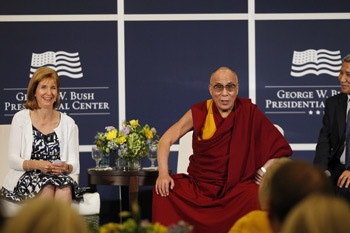Dallas, Texas, USA, 10 May 2011 - His Holiness the Dalai Lama began his day on May 10, 2011 with a meeting with former US Special Coordinator for Tibetan Issues, Paula Dobriansky.

|
| His Holiness the Dalai Lama is greeted by President George W. Bush and Mrs. Laura Bush in Dallas, Texas, on May 10, 2011. Photo/Layne Murdoch |
Afterwards, he left for the residence of President George W. Bush and Mrs. Laura Bush for a meeting with them. His Holiness spent around an hour with them. President Bush said he was honored with His Holiness’ coming. Later, speaking at a luncheon where President Bush was there, His Holiness said he had been waiting to meet President Bush again, calling him “my dear friend.”
His Holiness went from the Bush residence to the Meadows Museum of Southern Methodist University, the venue of an interview on democracy conducted by Ambassador Jim Glassman, who is the Executive Director of the George W. Bush Institute The interview will be broadcast on PBS (American public television) and also archived in the Bush Center’s democracy collection. In the interview His Holiness dwelt on his overall view of democracy being universal and explained the historical development of the Tibetan democratic experience.
Thereafter, His Holiness attended a luncheon hosted by the George W. Bush Center and was greeted at the door by President Bush. Ambassador Glassman in his welcome remarks announced that during the meeting with President Bush, His Holiness had presented a copy of the draft document, having His Holiness’ editorial correction, which resulted in the Constitution of Future Tibet promulgated in 1963. He said that this document is the first contribution to The Freedom Collection at the George W. Bush Institute, which “presents the personal stories of struggle and achievement told by the men and women who led freedom movements from the last century through present day.” Ambassador Glassman added that the document is being regarded as the founding document of the collection. The document is the copy of the Tibetan manuscript, Principles of the Constitution of Future Tibet, which was the framework for the Draft Constitution of Future Tibet of 1963. The Bush Center is releasing a statement on this document and photos on its Facebook page.

|
| His Holiness the Dalai Lama being interviewed for PBS in Dallas, Texas, on May 10, 2011. Photo/Layne Murdoch |
President Bush spoke next and recognized some individuals, including former senator Bill Frist. He said that he had been looking forward to today’s meeting with His Holiness saying that during his presidency there have been extraordinary moments and some of these were his meetings with His Holiness. He said, “When you spend time with him, you realize that there is something unusual about him.” The President called His Holiness “courageous but humble” and “a delight to be around.” “When I think of the Dalai lama, I smile,” he said. He said that His Holiness was courageous in the defense of liberty and understands that freedom means peace and he is a man of peace. Terming His Holiness’ presence as a “priceless contribution” to the Bush Center and a “great gesture of friendship,” the President invited him to the podium.
His Holiness began by saying that since their last meeting during the Congressional Gold Medal ceremony in 2007, he had been looking forward to meeting President Bush, whom he called “my dear friend.” Revealing that President Bush had telephoned him soon after his gall bladder surgery, His Holiness said that he felt greatly touched by the gesture.
His Holiness said that he considered the President’s support as being pro-justice and not pro-Tibet.

|
His Holiness speaking at the George W. Bush Presidential Center in Dallas, Texas, on May 10, 2011. Photo/Layne Murdoch
|
His Holiness said that irrespective of the status of people, whenever he met anyone he viewed that at the fundamental human level. Thus, from the first meeting with President Bush, His Holiness said that he found him “a wonderful person, a good person.”
Terming President Bush’ laudatory words about him as being “positive exaggeration,” His Holiness said he was fundamentally just one of the six billion human beings working to contribute his share for the wellbeing of humanity. Emphasizing the importance of developing inner peace, His Holiness said that even President Bush would know from his experience that money and power alone did not bring about inner peace. He added that scientists have also found that a warm-hearted person enjoyed better health.
His Holiness said his approach at promoting these human values is not based on religious belief but developed out of common sense, common experience and through scientific evidence.
His Holiness said that at the secondary level, he was a Buddhist and in the course of his meetings with leaders of the different spiritual faith, he found that all religions had the potential of bringing inner peace. Therefore, there was the need for inter-religious harmony, he said, adding that whether one liked it or not, realistically we all have to live together.
Talking about Tibet, His Holiness explained that everyone knows that he had relinquished political responsibility. However, he said he was a Tibetan. From this perspective he asked the people to understand the impact of Tibet to the world. He specifically highlighted the issue of Tibet’s ecology saying that Chinese scientists have termed the Tibetan plateau as the Third Pole to indicate its significance, equal to the north and the south poles. He said many of the rivers of Asia originate in Tibet and that more than a billion people depend on the water from these rivers.
His Holiness said caring for Tibetan ecology had nothing to do with politics. He commended former Chinese president Zhu Rongji for recognizing the importance of Tibetan forests for the environment and limiting deforestation for national interest. His Holiness, however, said that dues to corruption, etc., environmental degradation, including indiscriminate mining continue to be taking place in Tibet.
His Holiness concluded by suggesting that the participants in the luncheon who may know of ecologists could think of forming teams, in full co-operation with Chinese government officials, to study the status of Tibetan environment and to find ways to protect it.

|
| His Holiness answers questions from the audience at
the George W. Bush Presidential Center in Dallas, Texas, on May 10,
2011. Photo/Layne Murdoch |
His Holiness then took some questions from the audience in a session that was moderated by Ambassador Paula Dobriansky. To a question on whether the Chinese Communist regime was sustainable and whether there would be a democratic China, His Holiness said that China would change although no one knew when it would be. He said the Chinese authorities seem to be nervous about their position and referred to the report that the internal security budget of China surpassed that of the external defense budget.
Asked what were his greatest lessons, His Holiness said that the loss of his country was one; being the longest guest of the Government of India was another; appreciating the freedom of speech was another. His Holiness also said he learnt that tragedy brings about more inner strength adding that the Tibetan people were hardened by our tragedy.
His Holiness said that the world was heading towards a positive direction in response to another question. He recalled his conversation with the late Queen Mother of England who had lived for most of the 20th century and who had said that the humanity was becoming better as during her childhood days the issues of human rights and right to self-determination were not known. His Holiness also referred to increased ecological awareness as well as interest of scientists in inner values that showed the world was becoming better. His Holiness reminded everyone of the impact of global warming and said some of his people have said that next year 2012 there would be some solar storm.

|
His Holiness the Dalai Lama signs a Tibetan scroll painting presented to the George W Bush Presidential Center in Dallas Texas on May 10, 2011. Photo/Layne Murdoch
|
When asked whether he considered it an auspicious sign to be sharing the same birthday on July 6 with President Bush, His Holiness first joked that the question should be asked to the President. His Holiness said that some Tibetans believe that being born on the same day it was in order to work together. His Holiness said he was born in Asia and President Bush was born here but he believed that this meant that they had the same purpose for their lives. He said he was fully committed to democracy and suggested that President Bush to speak more forcefully for the promotion of democracy. Referring to the development in North Africa and the Middle East, His Holiness said he felt that President Bush could make a contribution on these issues.
Following his remarks, His Holiness presented a mounted Tibetan scroll painting of the Buddha for the George W. Bush Center.
His Holiness then departed for Fayetteville in the state of Arkansas for the next stage of his visit. On arrival officials of the University of Arkansas received him. His Holiness will have two events at the University on May 11. These will be webcast live on May 11 at 9:30 a.m. and 1:30 p.m (7 pm and 11 pm in India and 8:30 pm and 12:30 am in Tibet) will be streamed live at
http://globalcampus.uark.edu/HHDL/.

















